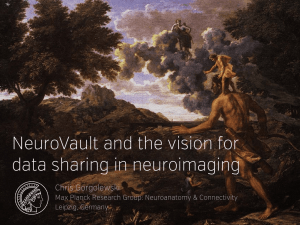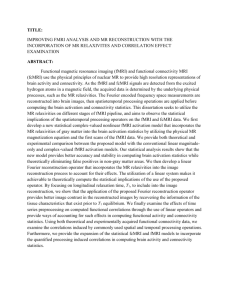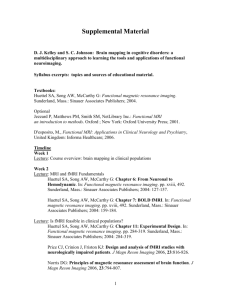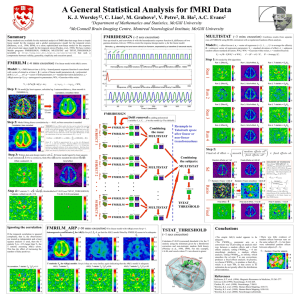Supplemental Information
advertisement
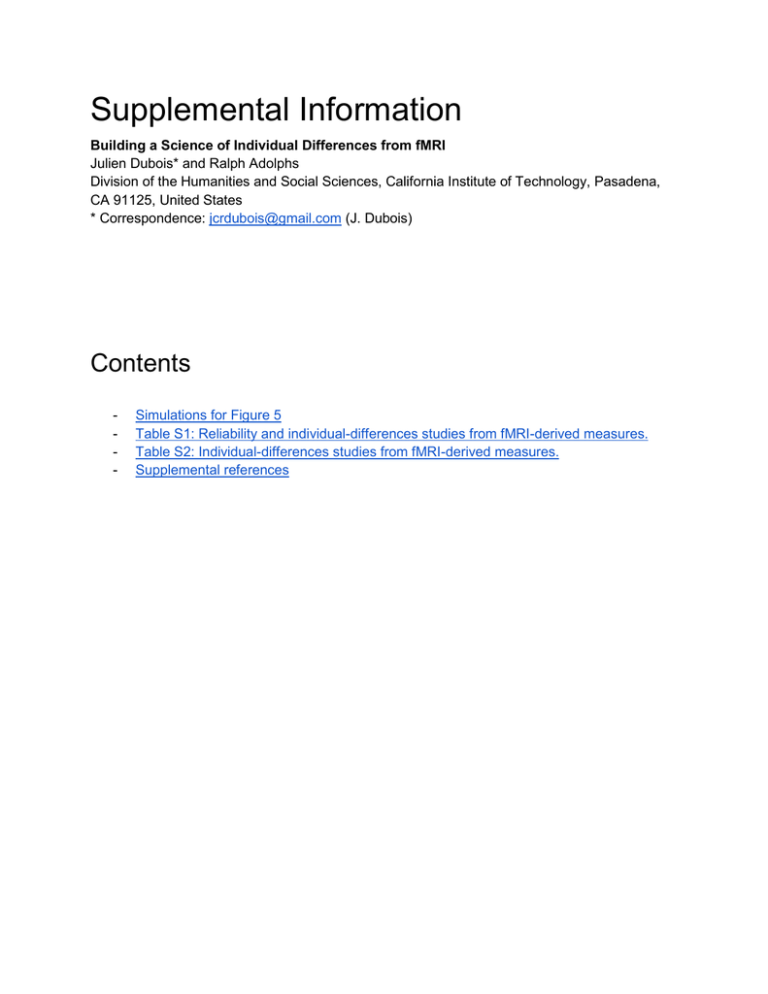
Supplemental Information Building a Science of Individual Differences from fMRI Julien Dubois* and Ralph Adolphs Division of the Humanities and Social Sciences, California Institute of Technology, Pasadena, CA 91125, United States * Correspondence: jcrdubois@gmail.com (J. Dubois) Contents - Simulations for Figure 5 Table S1: Reliability and individual-differences studies from fMRI-derived measures. Table S2: Individual-differences studies from fMRI-derived measures. Supplemental references Simulations for Figure 5. A large sample of 1,000,000 instances (the “population”) was drawn from two normally distributed variables, X and Y, using Matlab’s mvnrnd function with μX = μY = 0, σX=σY=1 and σXY=0.1. In this “population”, the correlation between X and Y is 0.1 -- a small effect size, representative of the effect size expected in fMRI studies of individual differences. 100,000 series of 1,000 samples were drawn randomly without replacement from the population. Pearson correlation was computed for sample sizes [10:5:100 120:20:200 250:50:500 600:100:1000] in each of the 100,000 series, yielding 100,000 trajectories of correlation values (gray lines in Figure 5(a) are 1,000 of these trajectories). A leave-one-out prediction based on a simple linear regression model was also performed at each sample size for each of the series, yielding 100,000 trajectories of prediction R-squared [R2=1-sum((Yreal-Ypred).^2)/sum((Yrealmean(Yreal)).^2)] (gray lines in Figure 5(b) are 1,000 of these trajectories). The exact same simulation was run with μX = μY = 0, σX=σY=1 and σXY=0, which represents the null hypothesis of no correlation between X and Y. All plots in Figure 5 are derived from these simulations. (back to TOC) Table S1 (related to Figure 1): Reliability and individual-differences studies from fMRIderived measures. There are many ways to analyze fMRI data, which is captured in this list of fMRI-derived measures. This table is included to elicit a sense of which measures have been studied in terms of reliability and assessed for individual differences in the literature so far, and which have not. Reliability column: studies are from a Pubmed search with terms “test-retest” AND “fMRI” since 2010-01-01 (273 results, which were then hand selected), plus studies reviewed in [1]. Individual differences column: studies are from a Pubmed search with terms “individual differences” AND “fMRI”, hand selecting the 100 most recent relevant studies. The Pubmed searches were conducted in November 2015. If a cell of the table was empty, we specifically searched for at least one relevant reference, and put a question mark if we did not find any. The purpose of this table is primarily illustrative, and it may be that we missed existing references given the fairly simple search strategy that we implemented. fMRI-derived measure Timelocked Reliability (between- and withinsubject) Individual differences AMPLITUDE of evoked activation (height) Yes [2–33] [30,34–95] EXTENT of evoked activation (voxel overlap) Yes [6,7,13,18,21,27,28,96–104] [105] PEAK LOCATION of evoked activation Yes [21] ? ONSET of evoked activation Yes [106] ? LAG of evoked activation (time-to-peak) Yes [106] ? DURATION of evoked activation (width) Yes [106] ? HABITUATION/ADAPTATION Yes [107] ? model-based regressor Yes [108] [109,110] ACCURACY of classification Yes ? ? PPI (Psychophysiological interactions) Yes [111] [66,82,112–116] DCM (dynamic causal Yes [117] ? modelling) Representational geometry Yes [118] [118,119] Inter-subject correlation Yes ? [120] ROI-to-ROI correlation No [101,111,121–139] [43,55,57,140–159] whole-brain FC No [137,160–162] [163] functional parcellation No [164–166] [166,167] ICA decomposition No [104,126,128,137,168–172] [173,174] network structure (graph edges) No [130,175] [162,176] graph-theoretical metrics No [128,131,132,137,175,177– 186] [82,187–190] dynamic connectivity No [191,192] [153,192,193] ALFF (amplitude of low frequency fluctuations, a.k.a. LFO) No [128,129,131,132,136,194– 198] [154,189,199,200] ReHo (regional homogeneity) No [128,129,131,132,136,201] [189,202,203] (back to TOC) Table S2 (related to Figure 1): Individual-differences studies from fMRI-derived measures. Studies from Table S1, individual differences column, were sorted by hand as relating fMRIderived measures to different aspects of individual differences Demographics age [91,204,205] gender [176] Neuropsychological test scores intelligence [89,188] personality [35,86,113] anxiety [53,62,74,144,156] depression [44,53,115] affect [30,41,50,85] creativity [158] other [42,46–48,51,58,70–72,75,76,79,90,94,149,153,189,206] Physiological measures [66,84,90] Behavioral task measures task performance or strategy [34,37– 39,43,45,49,52,54,56,57,59,60,63,68,73,77,80,81,83,87,88,90,91,105, 114,116,119,145–147,150–152,154,155,157,159,192,200,203,207– 212] reaction time [36,69,82] subjective ratings [38,40,55,61,67,112,118,148] Neuropsychiatric disorder disorder onset [78] future outcome [64,65,92] (back to TOC) Supplemental references 1 2 3 4 5 6 7 8 9 10 11 12 13 14 15 16 17 18 19 20 21 Bennett, C.M. and Miller, M.B. (2010) How reliable are the results from functional magnetic resonance imaging? Ann. N. Y. Acad. Sci. 1191, 133–155 Aron, A.R. et al. (2006) Long-term test-retest reliability of functional MRI in a classification learning task. Neuroimage 29, 1000–1006 Raemaekers, M. et al. (2007) Test–retest reliability of fMRI activation during prosaccades and antisaccades. Neuroimage 36, 532–542 Zandbelt, B.B. et al. (2008) Within-subject variation in BOLD-fMRI signal changes across repeated measurements: quantification and implications for sample size. Neuroimage 42, 196–206 Fliessbach, K. et al. (2010) Retest reliability of reward-related BOLD signals. Neuroimage 50, 1168–1176 Mc Kinsey, R.D. et al. (2010) Assessment of multiple task activation and reproducibility in patients with benign and low-grade neoplasms. Technol. Cancer Res. Treat. 9, 319–326 Atri, A. et al. (2011) Test-retest reliability of memory task functional magnetic resonance imaging in Alzheimer disease clinical trials. Arch. Neurol. 68, 599–606 Blokland, G.A.M. et al. (2011) Heritability of working memory brain activation. J. Neurosci. 31, 10882–10890 Koolschijn, P.C.M.P. et al. (2011) A three-year longitudinal functional magnetic resonance imaging study of performance monitoring and test-retest reliability from childhood to early adulthood. J. Neurosci. 31, 4204–4212 Putcha, D. et al. (2011) Reliability of functional magnetic resonance imaging associative encoding memory paradigms in non-demented elderly adults. Hum. Brain Mapp. 32, 2027– 2044 Plichta, M.M. et al. (2012) Test-retest reliability of evoked BOLD signals from a cognitiveemotive fMRI test battery. Neuroimage 60, 1746–1758 Raemaekers, M. et al. (2012) Test-retest variability underlying fMRI measurements. Neuroimage 60, 717–727 Sheu, L.K. et al. (2012) Test-retest reliability of an fMRI paradigm for studies of cardiovascular reactivity. Psychophysiology 49, 873–884 Swisher, J.D. et al. (2012) Multishot versus single-shot pulse sequences in very high field fMRI: a comparison using retinotopic mapping. PLoS One 7, e34626 Bennett, C.M. and Miller, M.B. (2013) fMRI reliability: influences of task and experimental design. Cogn. Affect. Behav. Neurosci. 13, 690–702 Brandt, D.J. et al. (2013) Test-Retest Reliability of fMRI Brain Activity during Memory Encoding. Front. Psychiatry 4, 163 De Simoni, S. et al. (2013) Test-retest reliability of the BOLD pharmacological MRI response to ketamine in healthy volunteers. Neuroimage 64, 75–90 Gorgolewski, K.J. et al. (2013) Single subject fMRI test-retest reliability metrics and confounding factors. Neuroimage 69, 231–243 Sauder, C.L. et al. (2013) Test-retest reliability of amygdala response to emotional faces. Psychophysiology 50, 1147–1156 van den Bulk, B.G. et al. (2013) How stable is activation in the amygdala and prefrontal cortex in adolescence? A study of emotional face processing across three measurements. Dev. Cogn. Neurosci. 4, 65–76 Weiss, C. et al. (2013) Mapping the hand, foot and face representations in the primary motor cortex - retest reliability of neuronavigated TMS versus functional MRI. Neuroimage 66, 531–542 22 Denison, R.N. et al. (2014) Functional mapping of the magnocellular and parvocellular subdivisions of human LGN. Neuroimage 102, 358–369 23 Fournier, J.C. et al. (2014) Model specification and the reliability of fMRI results: implications for longitudinal neuroimaging studies in psychiatry. PLoS One 9, e105169 24 Grimm, O. et al. (2014) Striatal response to reward anticipation: evidence for a systemslevel intermediate phenotype for schizophrenia. JAMA Psychiatry 71, 531–539 25 Hanlon, C.A. et al. (2013) Probing the frontostriatal loops involved in executive and limbic processing via interleaved TMS and functional MRI at two prefrontal locations: a pilot study. PLoS One 8, e67917 26 Letzen, J.E. et al. (2014) Test-retest reliability of pain-related brain activity in healthy controls undergoing experimental thermal pain. J. Pain 15, 1008–1014 27 Martuzzi, R. et al. (2014) Human finger somatotopy in areas 3b, 1, and 2: a 7T fMRI study using a natural stimulus. Hum. Brain Mapp. 35, 213–226 28 Quiton, R.L. et al. (2014) Intersession reliability of fMRI activation for heat pain and motor tasks. Neuroimage Clin 5, 309–321 29 Sousa, I. et al. (2014) Reproducibility of hypocapnic cerebrovascular reactivity measurements using BOLD fMRI in combination with a paced deep breathing task. Neuroimage 98, 31–41 30 Wu, C.C. et al. (2014) Affective traits link to reliable neural markers of incentive anticipation. Neuroimage 84, 279–289 31 Zanto, T.P. et al. (2014) Reliability measures of functional magnetic resonance imaging in a longitudinal evaluation of mild cognitive impairment. Neuroimage 84, 443–452 32 Upadhyay, J. et al. (2015) Test–retest reliability of evoked heat stimulation BOLD fMRI. J. Neurosci. Methods 253, 38–46 33 Overgaauw, S. et al. (2015) A longitudinal analysis of neural regions involved in reading the mind in the eyes. Soc. Cogn. Affect. Neurosci. 10, 619–627 34 Yamashiro, H. et al. (2014) Activity in early visual areas predicts interindividual differences in binocular rivalry dynamics. J. Neurophysiol. 111, 1190–1202 35 Weiland, B.J. et al. (2014) Relationship between impulsivity, prefrontal anticipatory activation, and striatal dopamine release during rewarded task performance. Psychiatry Res. 223, 244–252 36 Andoh, J. and Zatorre, R.J. (2013) Mapping interhemispheric connectivity using functional MRI after transcranial magnetic stimulation on the human auditory cortex. Neuroimage 79, 162–171 37 Ziaei, M. et al. (2014) Brain systems underlying attentional control and emotional distraction during working memory encoding. Neuroimage 87, 276–286 38 Aupperle, R.L. et al. (2015) Neural substrates of approach-avoidance conflict decisionmaking. Hum. Brain Mapp. 36, 449–462 39 Greening, S. et al. (2014) Individual differences in the anterior insula are associated with the likelihood of financially helping versus harming others. Cogn. Affect. Behav. Neurosci. 14, 266–277 40 Dew, I.T.Z. and Cabeza, R. (2013) A broader view of perirhinal function: from recognition memory to fluency-based decisions. J. Neurosci. 33, 14466–14474 41 Bjork, J.M. et al. (2014) Dietary tyrosine/phenylalanine depletion effects on behavioral and brain signatures of human motivational processing. Neuropsychopharmacology 39, 595– 604 42 Bangen, K.J. et al. (2014) Brains of optimistic older adults respond less to fearful faces. J. Neuropsychiatry Clin. Neurosci. 26, 155–163 43 Barnes, K.A. et al. (2014) Individual differences in intrinsic brain connectivity predict decision strategy. J. Neurophysiol. 112, 1838–1848 44 Eryilmaz, H. et al. (2014) Lasting impact of regret and gratification on resting brain activity and its relation to depressive traits. J. Neurosci. 34, 7825–7835 45 Benningfield, M.M. et al. (2014) Caudate responses to reward anticipation associated with delay discounting behavior in healthy youth. Dev. Cogn. Neurosci. 7, 43–52 46 Shankman, S.A. et al. (2014) Anterior insula responds to temporally unpredictable aversiveness: an fMRI study. Neuroreport 25, 596–600 47 Morelli, S.A. et al. (2014) The neural bases of feeling understood and not understood. Soc. Cogn. Affect. Neurosci. 9, 1890–1896 48 Steinbeis, N. and Singer, T. (2014) Projecting my envy onto you: neurocognitive mechanisms of an offline emotional egocentricity bias. Neuroimage 102, 370–380 49 Hehman, E. et al. (2014) The neural basis of stereotypic impact on multiple social categorization. Neuroimage 101, 704–711 50 Nelson, B.D. et al. (2015) Prefrontal engagement by cognitive reappraisal of negative faces. Behav. Brain Res. 279, 218–225 51 Rao, L.-L. et al. (2014) Probing the neural basis of superstition. Brain Topogr. 27, 766–770 52 McGettigan, C. et al. (2015) Individual Differences in Laughter Perception Reveal Roles for Mentalizing and Sensorimotor Systems in the Evaluation of Emotional Authenticity. Cereb. Cortex 25, 246–257 53 Keller, J. et al. (2013) Trait anhedonia is associated with reduced reactivity and connectivity of mesolimbic and paralimbic reward pathways. J. Psychiatr. Res. 47, 1319–1328 54 Dennis, N.A. et al. (2014) Age-related differences in the neural correlates mediating false recollection. Neurobiol. Aging 35, 395–407 55 Touroutoglou, A. et al. (2014) Amygdala task-evoked activity and task-free connectivity independently contribute to feelings of arousal. Hum. Brain Mapp. 35, 5316–5327 56 Huijbers, W. et al. (2014) Respiration phase-locks to fast stimulus presentations: implications for the interpretation of posterior midline “deactivations.” Hum. Brain Mapp. 35, 4932–4943 57 Hermann, P. et al. (2015) Neural basis of identity information extraction from noisy face images. J. Neurosci. 35, 7165–7173 58 Rüsch, N. et al. (2014) You and your kin: Neural signatures of family-based group perception in the subgenual cortex. Soc. Neurosci. 9, 326–331 59 Fera, F. et al. (2014) Hippocampal BOLD response during category learning predicts subsequent performance on transfer generalization. Hum. Brain Mapp. 35, 3122–3131 60 Frydman, C. et al. (2014) Using Neural Data to Test A Theory of Investor Behavior: An Application to Realization Utility. J. Finance 69, 907–946 61 Egidi, G. and Caramazza, A. (2014) Mood-dependent integration in discourse comprehension: happy and sad moods affect consistency processing via different brain networks. Neuroimage 103, 20–32 62 Galván, A. and Peris, T.S. (2014) Neural correlates of risky decision making in anxious youth and healthy controls. Depress. Anxiety 31, 591–598 63 Stanger, C. et al. (2013) Neuroeconomics and adolescent substance abuse: individual differences in neural networks and delay discounting. J. Am. Acad. Child Adolesc. Psychiatry 52, 747–755 64 Cousijn, J. et al. (2014) Effect of baseline cannabis use and working-memory network function on changes in cannabis use in heavy cannabis users: a prospective fMRI study. Hum. Brain Mapp. 35, 2470–2482 65 Sun, X. et al. (2015) Basolateral amygdala response to food cues in the absence of hunger is associated with weight gain susceptibility. J. Neurosci. 35, 7964–7976 66 Vachon-Presseau, E. et al. (2013) Acute stress contributes to individual differences in pain and pain-related brain activity in healthy and chronic pain patients. J. Neurosci. 33, 6826– 6833 67 Zarnhofer, S. et al. (2013) Individual differences in solving arithmetic word problems. Behav. Brain Funct. 9, 28 68 Cascio, C.N. et al. (2015) Buffering social influence: neural correlates of response inhibition predict driving safety in the presence of a peer. J. Cogn. Neurosci. 27, 83–95 69 Thakkar, K.N. et al. (2014) Frontal-subcortical circuits involved in reactive control and monitoring of gaze. J. Neurosci. 34, 8918–8929 70 Yoder, K.J. and Decety, J. (2014) The Good, the bad, and the just: justice sensitivity predicts neural response during moral evaluation of actions performed by others. J. Neurosci. 34, 4161–4166 71 Von Der Heide, R. et al. (2014) The social network-network: size is predicted by brain structure and function in the amygdala and paralimbic regions. Soc. Cogn. Affect. Neurosci. 9, 1962–1972 72 Hermann, A. et al. (2014) Dispositional cognitive reappraisal modulates the neural correlates of fear acquisition and extinction. Neurobiol. Learn. Mem. 113, 115–124 73 Kilts, C.D. et al. (2014) Individual differences in attentional bias associated with cocaine dependence are related to varying engagement of neural processing networks. Neuropsychopharmacology 39, 1135–1147 74 Carré, A. et al. (2014) Linear association between social anxiety symptoms and neural activations to angry faces: from subclinical to clinical levels. Soc. Cogn. Affect. Neurosci. 9, 880–886 75 Molenberghs, P. et al. (2014) The influence of group membership and individual differences in psychopathy and perspective taking on neural responses when punishing and rewarding others. Hum. Brain Mapp. 35, 4989–4999 76 Wilbertz, T. et al. (2014) Response inhibition and its relation to multidimensional impulsivity. Neuroimage 103, 241–248 77 Gess, J.L. et al. (2014) Task-dependent recruitment of intrinsic brain networks reflects normative variance in cognition. Brain Behav. 4, 650–664 78 Kitada, R. et al. (2014) The brain network underlying the recognition of hand gestures in the blind: the supramodal role of the extrastriate body area. J. Neurosci. 34, 10096–10108 79 Canessa, N. et al. (2013) The functional and structural neural basis of individual differences in loss aversion. J. Neurosci. 33, 14307–14317 80 Haruno, M. et al. (2014) Activity in the nucleus accumbens and amygdala underlies individual differences in prosocial and individualistic economic choices. J. Cogn. Neurosci. 26, 1861–1870 81 van Duijvenvoorde, A.C.K. et al. (2015) Neural correlates of expected risks and returns in risky choice across development. J. Neurosci. 35, 1549–1560 82 Dwyer, D.B. et al. (2014) Large-scale brain network dynamics supporting adolescent cognitive control. J. Neurosci. 34, 14096–14107 83 Metcalfe, A.W.S. et al. (2013) Fractionating the neural correlates of individual working memory components underlying arithmetic problem solving skills in children. Dev. Cogn. Neurosci. 6, 162–175 84 Puglia, M.H. et al. (2015) Epigenetic modification of the oxytocin receptor gene influences the perception of anger and fear in the human brain. Proc. Natl. Acad. Sci. U. S. A. 112, 3308–3313 85 Wilson, S.J. et al. (2014) Self-control, negative affect and neural activity during effortful cognition in deprived smokers. Soc. Cogn. Affect. Neurosci. 9, 887–894 86 Servaas, M.N. et al. (2014) The neural correlates of worry in association with individual differences in neuroticism. Hum. Brain Mapp. 35, 4303–4315 87 White, C.N. et al. (2014) Decomposing decision components in the stop-signal task: a model-based approach to individual differences in inhibitory control. J. Cogn. Neurosci. 26, 1601–1614 88 Ordaz, S.J. et al. (2013) Longitudinal growth curves of brain function underlying inhibitory control through adolescence. J. Neurosci. 33, 18109–18124 89 Ripke, S. et al. (2015) Common neural correlates of intertemporal choices and intelligence in adolescents. J. Cogn. Neurosci. 27, 387–399 90 Braams, B.R. et al. (2015) Longitudinal changes in adolescent risk-taking: a comprehensive study of neural responses to rewards, pubertal development, and risk-taking behavior. J. Neurosci. 35, 7226–7238 91 Peters, S. et al. (2014) Strategies influence neural activity for feedback learning across child and adolescent development. Neuropsychologia 62, 365–374 92 Swartz, J.R. et al. (2015) A neural biomarker of psychological vulnerability to future life stress. Neuron 85, 505–511 93 Denke, C. et al. (2014) Belief in a just world is associated with activity in insula and somatosensory cortices as a response to the perception of norm violations. Soc. Neurosci. 9, 514–521 94 Pincus, M. et al. (2014) The conforming brain and deontological resolve. PLoS One 9, e106061 95 Spunt, R.P. and Adolphs, R. (2015) Folk explanations of behavior: a specialized use of a domain-general mechanism. Psychol. Sci. 26, 724–736 96 Gountouna, V.-E. et al. (2010) Functional Magnetic Resonance Imaging (fMRI) reproducibility and variance components across visits and scanning sites with a finger tapping task. Neuroimage 49, 552–560 97 Churchill, N.W. et al. (2015) An Automated, Adaptive Framework for Optimizing Preprocessing Pipelines in Task-Based Functional MRI. PLoS One 10, e0131520 98 Lukasova, K. et al. (2014) Test-retest reliability of fMRI activation generated by different saccade tasks. J. Magn. Reson. Imaging 40, 37–46 99 Stevens, M.T.R. et al. (2013) Thresholds in fMRI studies: reliable for single subjects? J. Neurosci. Methods 219, 312–323 100 Wymbs, N.F. et al. (2013) Individual differences in neural regions functionally related to real and imagined stuttering. Brain Lang. 124, 153–164 101 Kristo, G. et al. (2014) Task and task-free FMRI reproducibility comparison for motor network identification. Hum. Brain Mapp. 35, 340–352 102 Gorgolewski, K.J. et al. (2012) Adaptive thresholding for reliable topological inference in single subject fMRI analysis. Front. Hum. Neurosci. 6, 245 103 Voyvodic, J.T. (2012) Reproducibility of single-subject fMRI language mapping with AMPLE normalization. J. Magn. Reson. Imaging 36, 569–580 104 Mannfolk, P. et al. (2011) Can resting-state functional MRI serve as a complement to taskbased mapping of sensorimotor function? A test–retest reliability study in healthy volunteers. J. Magn. Reson. Imaging 34, 511–517 105 Verghese, A. et al. (2014) Functional size of human visual area V1: a neural correlate of top-down attention. Neuroimage 93, 47–52 106 Shan, Z.Y. et al. (2014) Modeling of the hemodynamic responses in block design fMRI studies. J. Cereb. Blood Flow Metab. 34, 316–324 107 Plichta, M.M. et al. (2014) Amygdala habituation: a reliable fMRI phenotype. Neuroimage 103, 383–390 108 Chase, H.W. et al. (2015) Accounting for Dynamic Fluctuations across Time when Examining fMRI Test-Retest Reliability: Analysis of a Reward Paradigm in the EMBARC Study. PLoS One 10, e0126326 109 Suzuki, S. et al. (2012) Learning to simulate others’ decisions. Neuron 74, 1125–1137 110 De Martino, B. et al. (2013) In the mind of the market: theory of mind biases value computation during financial bubbles. Neuron 79, 1222–1231 111 Bilek, E. et al. (2013) Application of high-frequency repetitive transcranial magnetic 112 113 114 115 116 117 118 119 120 121 122 123 124 125 126 127 128 129 130 131 132 133 134 stimulation to the DLPFC alters human prefrontal-hippocampal functional interaction. J. Neurosci. 33, 7050–7056 Smith, D.V. et al. (2014) Functional connectivity with ventromedial prefrontal cortex reflects subjective value for social rewards. Soc. Cogn. Affect. Neurosci. 9, 2017–2025 van den Bos, W. et al. (2014) Connectivity strength of dissociable striatal tracts predict individual differences in temporal discounting. J. Neurosci. 34, 10298–10310 Jack, A. and Morris, J.P. (2014) Neocerebellar contributions to social perception in adolescents with autism spectrum disorder. Dev. Cogn. Neurosci. 10, 77–92 Ho, T.C. et al. (2014) Functional connectivity of negative emotional processing in adolescent depression. J. Affect. Disord. 155, 65–74 King, D.R. et al. (2015) Recollection-related increases in functional connectivity predict individual differences in memory accuracy. J. Neurosci. 35, 1763–1772 Frässle, S. et al. (2015) Test-retest reliability of dynamic causal modeling for fMRI. Neuroimage 117, 56–66 Charest, I. et al. (2014) Unique semantic space in the brain of each beholder predicts perceived similarity. Proc. Natl. Acad. Sci. U. S. A. 111, 14565–14570 Wolosin, S.M. et al. (2013) Distributed hippocampal patterns that discriminate reward context are associated with enhanced associative binding. J. Exp. Psychol. Gen. 142, 1264–1276 Byrge, L. et al. (2015) Idiosyncratic brain activation patterns are associated with poor social comprehension in autism. J. Neurosci. 35, 5837–5850 Shehzad, Z. et al. (2009) The Resting Brain: Unconstrained yet Reliable. Cereb. Cortex 19, 2209–2229 Honey, C.J. et al. (2009) Predicting human resting-state functional connectivity from structural connectivity. Proc. Natl. Acad. Sci. U. S. A. 106, 2035–2040 Liu, H. et al. (2009) Evidence from intrinsic activity that asymmetry of the human brain is controlled by multiple factors. Proc. Natl. Acad. Sci. U. S. A. 106, 20499–20503 Van Dijk, K.R.A. et al. (2010) Intrinsic functional connectivity as a tool for human connectomics: theory, properties, and optimization. J. Neurophysiol. 103, 297–321 Ganger, S. et al. (2015) Comparison of continuously acquired resting state and extracted analogues from active tasks. Hum. Brain Mapp. 36, 4053–4063 Jovicich, J. et al. (2016) Longitudinal reproducibility of default-mode network connectivity in healthy elderly participants: A multicentric resting-state fMRI study. Neuroimage 124, 442– 454 Birn, R.M. et al. (2014) The influence of physiological noise correction on test-retest reliability of resting-state functional connectivity. Brain Connect. 4, 511–522 Zuo, X.-N. and Xing, X.-X. (2014) Test-retest reliabilities of resting-state FMRI measurements in human brain functional connectomics: a systems neuroscience perspective. Neurosci. Biobehav. Rev. 45, 100–118 Liu, D. et al. (2013) Eyes-open/eyes-closed dataset sharing for reproducibility evaluation of resting state fMRI data analysis methods. Neuroinformatics 11, 469–476 Birn, R.M. et al. (2013) The effect of scan length on the reliability of resting-state fMRI connectivity estimates. Neuroimage 83, 550–558 Yan, C.-G. et al. (2013) Standardizing the intrinsic brain: towards robust measurement of inter-individual variation in 1000 functional connectomes. Neuroimage 80, 246–262 Yan, C.-G. et al. (2013) A comprehensive assessment of regional variation in the impact of head micromovements on functional connectomics. Neuroimage 76, 183–201 Patriat, R. et al. (2013) The effect of resting condition on resting-state fMRI reliability and consistency: a comparison between resting with eyes open, closed, and fixated. Neuroimage 78, 463–473 Song, J. et al. (2012) Age-related differences in test-retest reliability in resting-state brain functional connectivity. PLoS One 7, e49847 135 Fiecas, M. et al. (2013) Quantifying temporal correlations: a test-retest evaluation of functional connectivity in resting-state fMRI. Neuroimage 65, 231–241 136 Li, Z. et al. (2012) Test–retest stability analysis of resting brain activity revealed by blood oxygen level-dependent functional MRI. J. Magn. Reson. Imaging 36, 344–354 137 Guo, C.C. et al. (2012) One-year test-retest reliability of intrinsic connectivity network fMRI in older adults. Neuroimage 61, 1471–1483 138 Chou, Y.-H. et al. (2012) Investigation of long-term reproducibility of intrinsic connectivity network mapping: a resting-state fMRI study. AJNR Am. J. Neuroradiol. 33, 833–838 139 Seibert, T.M. et al. (2012) Stability of resting fMRI interregional correlations analyzed in subject-native space: a one-year longitudinal study in healthy adults and premanifest Huntington’s disease. Neuroimage 59, 2452–2463 140 Andrews-Hanna, J.R. et al. (2007) Disruption of large-scale brain systems in advanced aging. Neuron 56, 924–935 141 Song, M. et al. (2008) Brain spontaneous functional connectivity and intelligence. Neuroimage 41, 1168–1176 142 Mennes, M. et al. (2010) Inter-individual differences in resting-state functional connectivity predict task-induced BOLD activity. Neuroimage 50, 1690–1701 143 Adelstein, J.S. et al. (2011) Personality is reflected in the brain’s intrinsic functional architecture. PLoS One 6, e27633 144 Bijsterbosch, J. et al. (2014) Resting state correlates of subdimensions of anxious affect. J. Cogn. Neurosci. 26, 914–926 145 Bassett, D.S. et al. (2015) Learning-induced autonomy of sensorimotor systems. Nat. Neurosci. 18, 744–751 146 Breckel, T.P.K. et al. (2013) Long-term effects of attentional performance on functional brain network topology. PLoS One 8, e74125 147 Supekar, K. et al. (2013) Neural predictors of individual differences in response to math tutoring in primary-grade school children. Proc. Natl. Acad. Sci. U. S. A. 110, 8230–8235 148 McGeown, W.J. et al. (2015) Structural and functional correlates of hypnotic depth and suggestibility. Psychiatry Res. 231, 151–159 149 Kucyi, A. et al. (2014) Enhanced medial prefrontal-default mode network functional connectivity in chronic pain and its association with pain rumination. J. Neurosci. 34, 3969– 3975 150 Persson, J. et al. (2014) Longitudinal assessment of default-mode brain function in aging. Neurobiol. Aging 35, 2107–2117 151 Gerraty, R.T. et al. (2014) Transfer of learning relates to intrinsic connectivity between hippocampus, ventromedial prefrontal cortex, and large-scale networks. J. Neurosci. 34, 11297–11303 152 Gordon, E.M. et al. (2015) Resting-state striato-frontal functional connectivity is sensitive to DAT1 genotype and predicts executive function. Cereb. Cortex 25, 336–345 153 Kucyi, A. and Davis, K.D. (2014) Dynamic functional connectivity of the default mode network tracks daydreaming. Neuroimage 100, 471–480 154 Xu, J. et al. (2014) Spontaneous neuronal activity predicts intersubject variations in executive control of attention. Neuroscience 263, 181–192 155 Clewett, D. et al. (2014) Increased functional coupling between the left fronto-parietal network and anterior insula predicts steeper delay discounting in smokers. Hum. Brain Mapp. 35, 3774–3787 156 Qin, S. et al. (2014) Amygdala subregional structure and intrinsic functional connectivity predicts individual differences in anxiety during early childhood. Biol. Psychiatry 75, 892– 900 157 Cheng, J.C. et al. (2015) Individual Differences in Temporal Summation of Pain Reflect 158 159 160 161 162 163 164 165 166 167 168 169 170 171 172 173 174 175 176 177 178 179 180 Pronociceptive and Antinociceptive Brain Structure and Function. J. Neurosci. 35, 9689– 9700 Wei, D. et al. (2014) Increased resting functional connectivity of the medial prefrontal cortex in creativity by means of cognitive stimulation. Cortex 51, 92–102 Ventura-Campos, N. et al. (2013) Spontaneous brain activity predicts learning ability of foreign sounds. J. Neurosci. 33, 9295–9305 Faria, A.V. et al. (2012) Atlas-based analysis of resting-state functional connectivity: evaluation for reproducibility and multi-modal anatomy-function correlation studies. Neuroimage 61, 613–621 Cole, M.W. et al. (2014) Intrinsic and task-evoked network architectures of the human brain. Neuron 83, 238–251 Geerligs, L. et al. (2015) State and Trait Components of Functional Connectivity: Individual Differences Vary with Mental State. J. Neurosci. 35, 13949–13961 Finn, E.S. et al. (2015) Functional connectome fingerprinting: identifying individuals using patterns of brain connectivity. Nat. Neurosci. 18, 1664–1671 Laumann, T.O. et al. (2015) Functional System and Areal Organization of a Highly Sampled Individual Human Brain. Neuron 87, 657–670 Mejia, A.F. et al. (2015) Improving reliability of subject-level resting-state fMRI parcellation with shrinkage estimators. Neuroimage 112, 14–29 Wang, D. et al. (2015) Parcellating cortical functional networks in individuals. Nat. Neurosci. 18, 1853–1860 Mueller, S. et al. (2013) Individual variability in functional connectivity architecture of the human brain. Neuron 77, 586–595 Meindl, T. et al. (2010) Test–retest reproducibility of the default-mode network in healthy individuals. Hum. Brain Mapp. 31, 237–246 Zuo, X.-N. et al. (2010) Reliable intrinsic connectivity networks: test-retest evaluation using ICA and dual regression approach. Neuroimage 49, 2163–2177 Poppe, A.B. et al. (2013) Toward a neurometric foundation for probabilistic independent component analysis of fMRI data. Cogn. Affect. Behav. Neurosci. 13, 641–659 Blautzik, J. et al. (2013) Long-term test-retest reliability of resting-state networks in healthy elderly subjects and with amnestic mild cognitive impairment patients. J. Alzheimers. Dis. 34, 741–754 Jann, K. et al. (2015) Functional connectivity in BOLD and CBF data: similarity and reliability of resting brain networks. Neuroimage 106, 111–122 Allen, E.A. et al. (2012) Capturing inter-subject variability with group independent component analysis of fMRI data: a simulation study. Neuroimage 59, 4141–4159 Smith, D.V. et al. (2014) Characterizing individual differences in functional connectivity using dual-regression and seed-based approaches. Neuroimage 95, 1–12 Weber, M.J. et al. (2013) Reproducibility of functional network metrics and network structure: a comparison of task-related BOLD, resting ASL with BOLD contrast, and resting cerebral blood flow. Cogn. Affect. Behav. Neurosci. 13, 627–640 Smith, S.M. et al. (2013) Functional connectomics from resting-state fMRI. Trends Cogn. Sci. 17, 666–682 Braun, U. et al. (2012) Test-retest reliability of resting-state connectivity network characteristics using fMRI and graph theoretical measures. Neuroimage 59, 1404–1412 Andellini, M. et al. (2015) Test-retest reliability of graph metrics of resting state MRI functional brain networks: A review. J. Neurosci. Methods 253, 183–192 Du, H.-X. et al. (2015) Test-Retest Reliability of Graph Metrics in High‐ resolution Functional Connectomics: A Resting‐ State Functional MRI Study. CNS Neuroscience and Therapeutics Wang, Y. et al. (2014) Reproducibility and robustness of graph measures of the associative-semantic network. PLoS One 9, e115215 181 Tomasi, D. and Volkow, N.D. (2014) Mapping small-world properties through development in the human brain: disruption in schizophrenia. PLoS One 9, e96176 182 Cao, H. et al. (2014) Test-retest reliability of fMRI-based graph theoretical properties during working memory, emotion processing, and resting state. Neuroimage 84, 888–900 183 Liao, X.-H. et al. (2013) Functional brain hubs and their test-retest reliability: a multiband resting-state functional MRI study. Neuroimage 83, 969–982 184 Wang, J.-H. et al. (2011) Graph theoretical analysis of functional brain networks: test-retest evaluation on short- and long-term resting-state functional MRI data. PLoS One 6, e21976 185 Liang, X. et al. (2012) Effects of different correlation metrics and preprocessing factors on small-world brain functional networks: a resting-state functional MRI study. PLoS One 7, e32766 186 Telesford, Q.K. et al. (2010) Reproducibility of graph metrics in FMRI networks. Front. Neuroinform. 4, 117 187 van den Heuvel, M.P. et al. (2009) Efficiency of functional brain networks and intellectual performance. J. Neurosci. 29, 7619–7624 188 Santarnecchi, E. et al. (2014) Efficiency of weak brain connections support general cognitive functioning. Hum. Brain Mapp. 35, 4566–4582 189 Gorgolewski, K.J. et al. (2014) A correspondence between individual differences in the brain’s intrinsic functional architecture and the content and form of self-generated thoughts. PLoS One 9, e97176 190 Arnemann, K.L. et al. (2015) Functional brain network modularity predicts response to cognitive training after brain injury. Neurology 84, 1568–1574 191 Lindquist, M.A. et al. (2014) Evaluating dynamic bivariate correlations in resting-state fMRI: a comparison study and a new approach. Neuroimage 101, 531–546 192 Yang, Z. et al. (2014) Common intrinsic connectivity states among posteromedial cortex subdivisions: Insights from analysis of temporal dynamics. Neuroimage 93, 124–137 193 Damaraju, E. et al. (2014) Dynamic functional connectivity analysis reveals transient states of dysconnectivity in schizophrenia. Neuroimage Clin 5, 298–308 194 Zuo, X.-N. et al. (2010) The oscillating brain: complex and reliable. Neuroimage 49, 1432– 1445 195 Zou, Q. et al. (2015) Reliability comparison of spontaneous brain activities between BOLD and CBF contrasts in eyes-open and eyes-closed resting states. Neuroimage 121, 91–105 196 Mao, D. et al. (2015) Low-Frequency Fluctuations of the Resting Brain: High Magnitude Does Not Equal High Reliability. PLoS One 10, e0128117 197 Wang, X. et al. (2013) Investigating univariate temporal patterns for intrinsic connectivity networks based on complexity and low-frequency oscillation: a test-retest reliability study. Neuroscience 254, 404–426 198 Turner, J.A. et al. (2012) Reliability of the amplitude of low-frequency fluctuations in resting state fMRI in chronic schizophrenia. Psychiatry Res. 201, 253–255 199 Mennes, M. et al. (2011) Linking inter-individual differences in neural activation and behavior to intrinsic brain dynamics. Neuroimage 54, 2950–2959 200 Zhou, Y. et al. (2014) Hyper-coupling between working memory task-evoked activations and amplitude of spontaneous fluctuations in first-episode schizophrenia. Schizophr. Res. 159, 80–89 201 Zuo, X.-N. et al. (2013) Toward reliable characterization of functional homogeneity in the human brain: preprocessing, scan duration, imaging resolution and computational space. Neuroimage 65, 374–386 202 Wei, L. et al. (2011) The synchronization of spontaneous BOLD activity predicts extraversion and neuroticism. Brain Res. 1419, 68–75 203 Wang, T. et al. (2014) Linking inter-individual differences in the conflict adaptation effect to spontaneous brain activity. Neuroimage 90, 146–152 204 Geerligs, L. et al. (2015) A Brain-Wide Study of Age-Related Changes in Functional Connectivity. Cereb. Cortex 25, 1987–1999 205 Haist, F. et al. (2015) Development of brain systems for nonsymbolic numerosity and the relationship to formal math academic achievement. Hum. Brain Mapp. 36, 804–826 206 Schwarzkopf, D.S. et al. (2014) Larger extrastriate population receptive fields in autism spectrum disorders. J. Neurosci. 34, 2713–2724 207 Anderson, D.E. et al. (2013) Attending multiple items decreases the selectivity of population responses in human primary visual cortex. J. Neurosci. 33, 9273–9282 208 Burzynska, A.Z. et al. (2013) A scaffold for efficiency in the human brain. J. Neurosci. 33, 17150–17159 209 Wardle, M.C. et al. (2013) The caudate signals bad reputation during trust decisions. PLoS One 8, e68884 210 Furman, A.J. et al. (2014) Persistent and stable biases in spatial learning mechanisms predict navigational style. Cogn. Affect. Behav. Neurosci. 14, 1375–1391 211 Herrmann, B. et al. (2014) Supplementary motor area activations predict individual differences in temporal-change sensitivity and its illusory distortions. Neuroimage 101, 370– 379 212 O’Neil, E.B. et al. (2014) Resting-state fMRI reveals functional connectivity between faceselective perirhinal cortex and the fusiform face area related to face inversion. Neuroimage 92, 349–355 (back to TOC)


